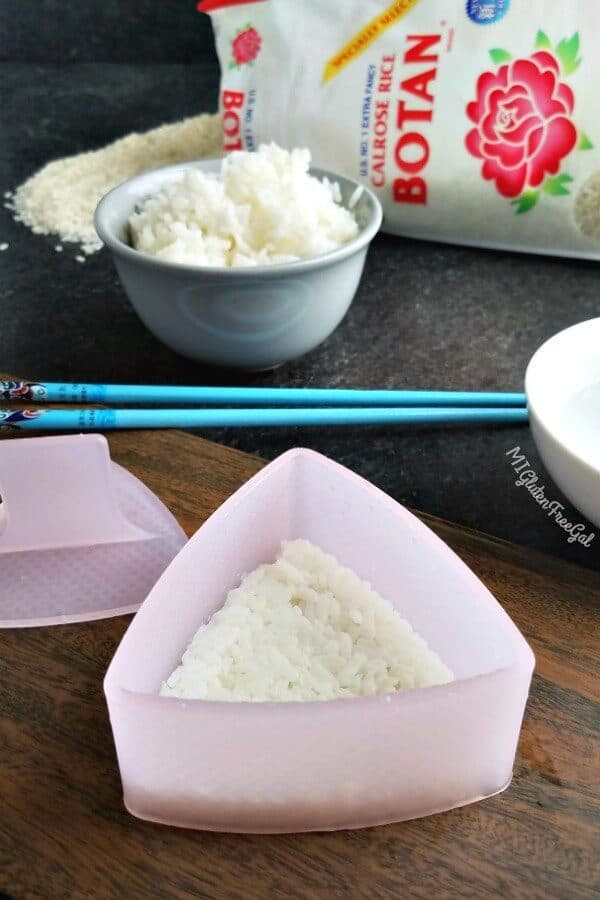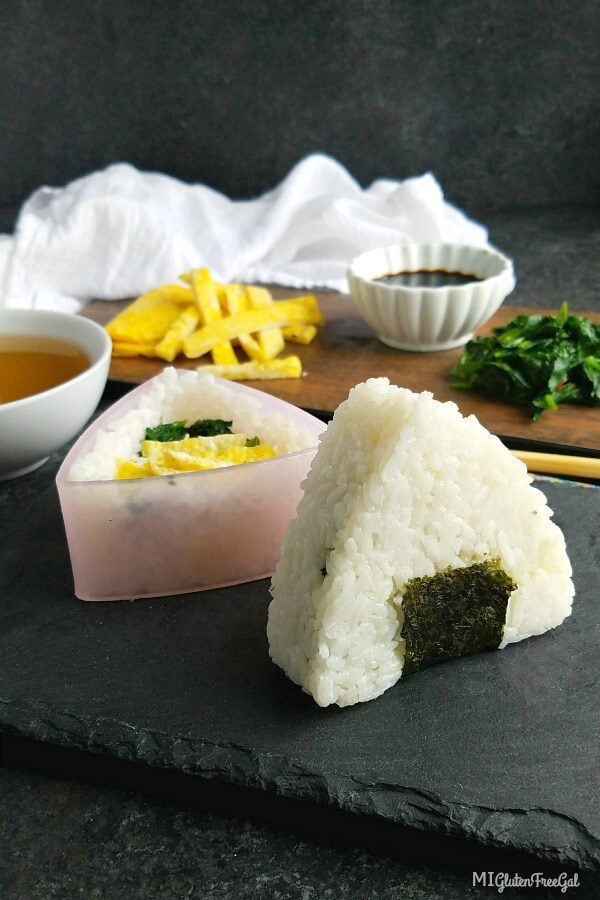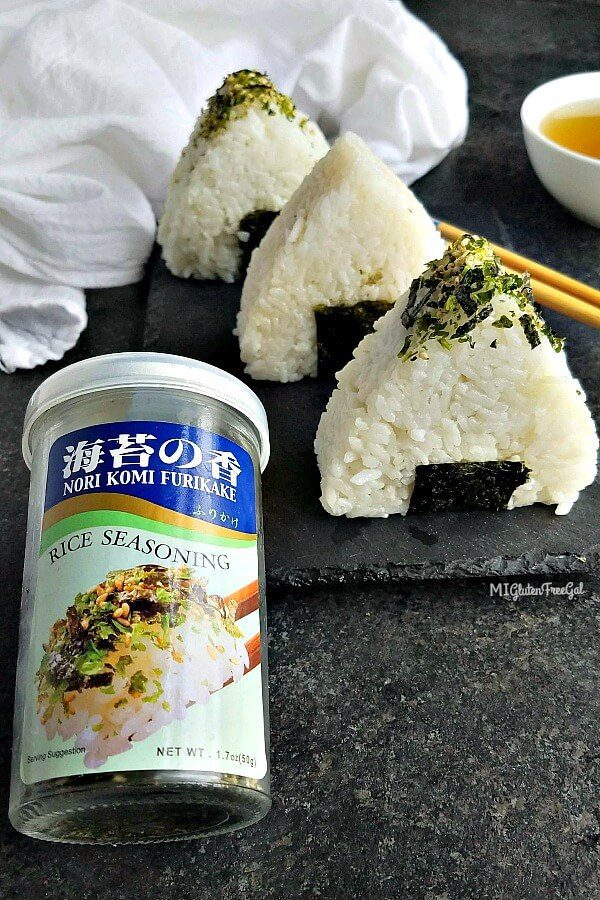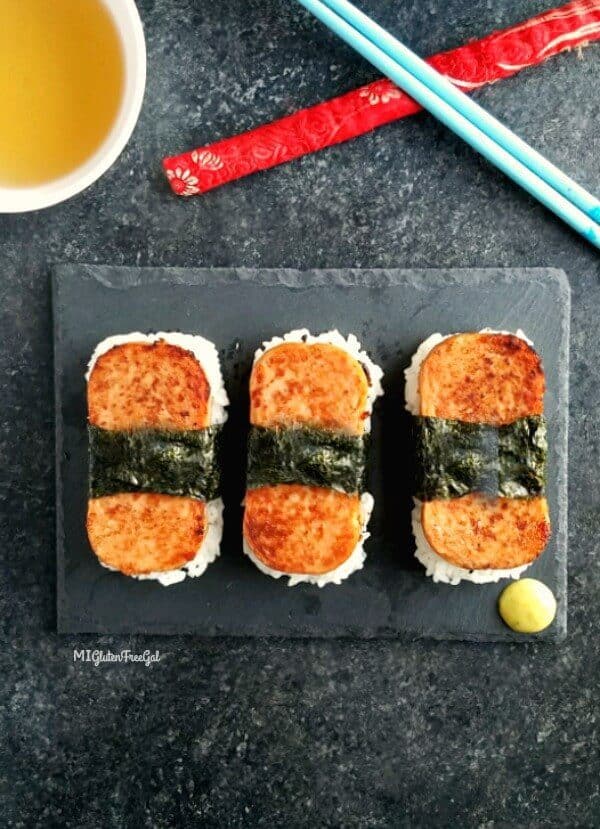Onigiri: Japanese Alternative to Sandwiches
As an Amazon Associate and member of other affiliate programs, I earn from qualifying purchases.
Sandwiches are the quintessential, inexpensive American lunch. Peanut butter and jelly. Ham and cheese. When you live with Celiac Disease or other food allergies, sandwiches become a much more expensive “easy” lunch. That’s why I LOVE onigiri. Made from rice and savory fillings, this naturally gluten free dish can be made with any filling you wish!

What is Onigiri? How is it Different than Sushi?
Onigiri (O-Knee-Gree) is a Japanese lunchtime staple. This dish works best with sushi rice. Sushi rice has a “sticky” consistency that holds together better than brown or regular white rice. People form onigiri into many shapes. However, the triangular form is most traditional shape. Also, Onigiri is not sushi. Sushi is different because sugar and vinegar are added to the rice.
Origins of Onigiri
According to Wikipedia, it dates back to the 11th century or even farther. Apparently these rice balls became popular before the use of chopsticks. Historians say samurai would “store rice balls wrapped in bamboo sheath.” This would provide a quick meal while they were on the front lines of a battle.
We learned about onigiri because my husband teaches an after school anime club. Ever since then, we’ve been fascinated with it! One of the most informative (and highly amusing) sources for Japanese cooking is a YouTube show called “Cooking With Dog.” The host is Francis, a poodle that sits on the kitchen countertop. He does the talking while the female chef prepares the food.
Onigiri Fillings
Because of its Japanese origins, onigiri has some traditional fillings that are unique. Some more ethnic fillings include pickled fruit, caviar, fried tempura and short ribs. Preserved fish mixed with mayonnaise is also popular. However, you can get totally creative. You could also use pulled pork or chicken.

How Do You Make Onigiri?
Onigiri is very easy to make. The first step is to cook your rice and let it cool slightly, so you can work it with your hands. Most people add a bit of salt water. We purchased a small triangular form at the local Asian market. While you don’t need it, it makes forming onigiri drastically easier.
My husband and I don’t follow a standard recipe when we make onigiri. We just kind of wing it. However, Kim Chi Mari has a great recipe for Joomukbap, which is the Korean version of onigiri. I highly recommed following her!
How Much Sushi Rice Should I Use?
To form your onigiri, use a plate or parchment paper as your work surface. Place your form on your work surface and add a few tablespoons of rice. Don’t fill it more than a 1/3 of the way full. Next, add a layer of your preferred filling.
Top the filling with a few more tablespoons of rice and use the form press to squeeze the layers together. To finish it off, take a small strip of nori (dried seaweed) and wrap it around the bottom. The strip should go stretch between the two flat sides of rice. The nori gives your fingers something to hold on to.

My Personal Tip for Making Onigiri
After I press the bottom portion of rice, I build a small ridge of rice around the inside of the form. You basically create a well for the filling. You can see it easier here in my spinach and omelette onigiri. Which is 100% delicious, by the way. A great option if you prefer to not eat meat. Also great if you’re looking for breakfast on the go!

A Note About Furikake
Sometimes the Japanese top their onigiri with furikake. This rice seasoning a mix of seaweed, sesame seeds, sugar and other seasonings. When you make multiple versions of onigiri, this can be helpful for distinguishing the differences between fillings. **It contains sesame seeds.
For example, the ones topped with furikake are filled with spinach and omelette. The ones without is filled with salmon and mayo. Some people mix he furikake with the rice itself, prior to forming their rice balls. *Note- Not all Furikake seasonings are gluten free. USA made Maine’s Balance Furikake is labeled gluten free.

Spam Musubi?
The Japanese form onigiri into other shapes as well, such as this musubi made with Turkey SPAM. I know what you’re thinking. SPAM? The Japanese love SPAM, so it seemed like an obvious option. I packed it in my husband’s lunch and he raved about it when he got home.
Other Handheld Gluten Free Meals
Love handheld meals? Check out my recipe for El Salvadoran pupusas or my grain-free pasties. My gluten free pigs in a blanket work great for lunch, too! Or my gluten free cheeseburger muffins.
What other unique things do you eat instead of sandwiches? Do you make onigiri? If so, leave me a comment below with your favorite filling!

To answer your question: We also love knishes! Dough wrapped around a filling of potatoes, or a cheesy-spinachey filling (which I make dairy-free by using a tofu mixture instead of cheese). Yum!
I’ll also sometimes bake a sheet of cornbread about 1/2 inch tall, cut into triangles, and use that for open sandwiches. Yum!
Hi, I shared this on your FB post and you asked me to share here:
I have a friend that makes these in a big batch and freezes them. She wraps them in plastic wrap then foil. Then put them in a ziplock bag in her freezer. Then when she wants one you just pull out to defrost and eat. She used them a lot for traveling and day trips with her kids as lunches.
Thanks for sharing!